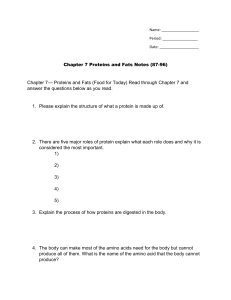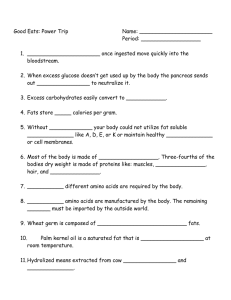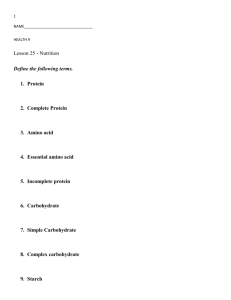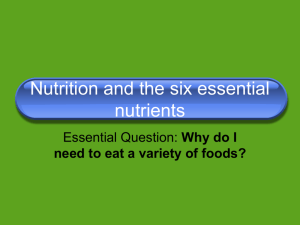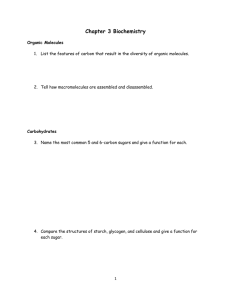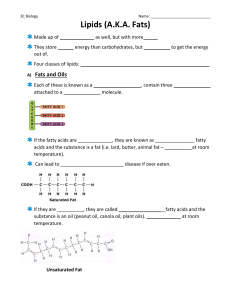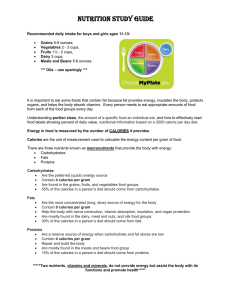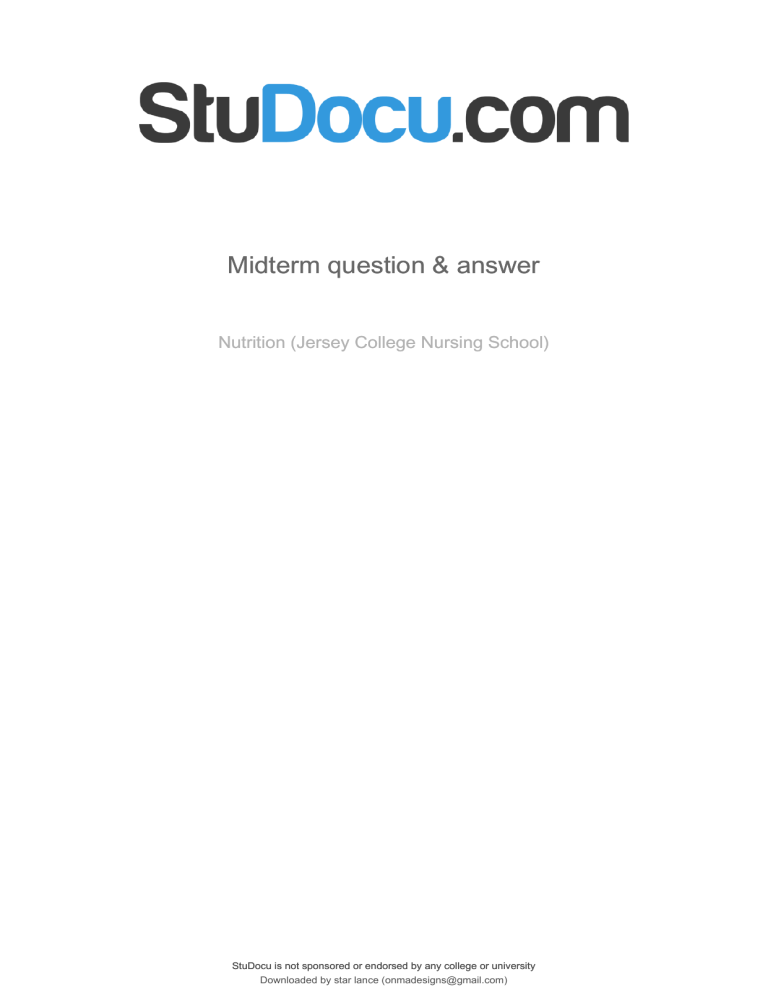
lOMoARcPSD|4526122 Midterm question & answer Nutrition (Jersey College Nursing School) StuDocu is not sponsored or endorsed by any college or university Downloaded by star lance (onmadesigns@gmail.com) lOMoARcPSD|4526122 Chapters 1-7 Practice Question Answers Which of the following best defines nutrition? a) A science that includes everything about food. b) A science that tells you how to eat. c) A science that older than other sciences. d) A science that pertains primarily to the American diet. Answer: a) Nutrition contributes to Wellness. Which of the following describes how nutrition can contribute to wellness? a) Providing energy for physical activity and brain function. b) Preventing and treating specific chronic illness. c) Providing an opportunity for social interaction. d) All of the above are ways that nutrition can contribute to wellness. Answer: d) According to the United States Department of Agriculture Food Database a large hard boiled egg provides 60 Calories and 6 grams of protein. How many Calories are coming from protein? a) 60 Calories b) 54 Calories c) 6 Calories d) 24 Calories Answer: (d) The USDA is a good source of nutrient information. The macronutrient protein provides 4 Calories per gram. 6 grams x 4 Calories/gram = ______ Calories. 6 grams x 4 Calories/gram = 24 Calories from Protein Which of the following is the term used to identify nutrients that are required in relatively small amounts? a) Macronutrients b) Micronutrients c) Trace nutrients d) Organic nutrients Answer: b) Water is an important nutrient. Which of the following is a function of water in the body? a) Transport of nutrients b) Regulation of nerve impulses c) Regulation of body temperature d) All of the above are functions of water in the body Answer: d) Downloaded by star lance (onmadesigns@gmail.com) lOMoARcPSD|4526122 Which of the following is NOT a micronutrient? a) Vitamin C b) Calcium c) Protein d) They are all micronutrients Answer: c) The Dietary Reference Intakes (DRIs) are specific reference values for nutrient intake. Which of the following DRIs would meet the nutrient needs for the greatest number of people within a specific group of people? a) Adequate Intake b) Tolerable Upper Limit c) Estimated Average Requirement d) Recommended Dietary Allowance Answer: d) Why do we use the scientific method to provide evidence to support a hypothesis? a) This method is a systematic way to answer questions. b) This method requires the researcher to make observations. c) This method develops a repeatable experiment to answer the research question. d) All of the above are reasons to use the scientific method as a way to gather data to support or reject a hypothesis. Answer: d) The steps in scientific method include: 1. Make an observation 2. Propose a hypothesis 3. Develop a repeatable experiment 4. Collect and analyze data 5. Either support or reject the hypothesis 6. Draw conclusions from the results What qualifications would not be helpful in determining high-quality, reliable nutrition information? a) Number of products that can be purchased associated with the information. b) Credentials of the individual. c) Education of the individual. d) Representing agency. Answer a) Which of the following terms would be used for a diet made up of food and beverages that supplies high level of nutrients for fewer calories? a) Nutrient-dense b) Moderate c) Balanced d) Adequate Answer: a) Downloaded by star lance (onmadesigns@gmail.com) lOMoARcPSD|4526122 A food label includes the Percent Daily Values for the food in the package. If a food contained 30% of the %DV for fat, would this be a food be high in fat or low in fat? a) High b) Low Answer: a) Health and nutrient claims made by food companies must be approved by a) the company producing the food. b) the state in which the food is produced. c) the U.S. Food and Drug Administration. d) the U.S. Department of Agriculture. Answer: c) In order to claim that the a food is fat free or sugar free it must contain which of the following? a) The food must contain less than 20 kcal from fat or from sugar per serving. b) The food must contain less than 3 g of fat or of sugar per serving. c) The food must contain 0 g of fat or of sugar per serving. d) The food must contain 0.5 g of fat or of sugar per serving. Answer: d) Which of the following is a Dietary Guideline recommended by the USDA and the USDHHS? a) Limit calories from added sugars and saturated fats, and reduce your sodium intake. b) Provide a statement of identity and an ingredient list on food labels. c) Eat a variety of foods in moderation. d) Change conditioned taste aversions by reintroducing foods. Answer: a) The USDA has developed recommended daily serving for five major food groups. According to these recommendations, what is the recommendation for vegetables? a) 3 oz per day b) 2.5 cups per day c) 1.5 cups per day d) 5.5 oz per day Answer: b) Fast food meals oftentimes provide dense caloric content. Which of the following can help to reduce the calories consumed when eating at a fast-food restaurant? a) Sharing a meal with a friend b) Choosing smaller portions c) Eating only half of the meal d) All of the above are methods to decrease the caloric intake at a fast-food restaurant Answer: d) Downloaded by star lance (onmadesigns@gmail.com) lOMoARcPSD|4526122 What term is used for a serving size that is one ounce for grains or proteins? a) Ounce-equivalent b) Normal serving size c) Metric serving size d) Small serving size Answer: a) Calories coming from solid fats and added sugars are called a) bad calories. b) high calories. c) empty calories. d) dense calories. Answer: c) Which of the following is the smallest biological unit of all living organisms? a) Atom b) Cell c) Organs d) Tissues Answer: b) Which of the following is the physiological need to eat? a) Anorexia b) Appetite c) Hunger d) Satiety Answer: c) Which of the following is responsible for the signal of hunger? a) Hypothalamus b) Nerve cells in the GI tract c) Hormones d) All of the above are responsible for the feeling of hunger Answer: d) Although your digestive tract is a long tube, it is separated into compartments by a) sphincters. b) accessory organs. c) multi-flapped valves. d) none of the above, the digestive tract has no separations. Answer: a) Which of the following enzymes begins the digestions of carbohydrates? a) Salivary lipase b) Pepsin c) Hydrochloric acid d) Salivary amylase Answer: d) Downloaded by star lance (onmadesigns@gmail.com) lOMoARcPSD|4526122 The movement throughout the digestive tract that is rhythmic and wavy in nature is a) peristalsis. b) segmentation. c) secretion. d) mastication. Answer: a) The majority of absorption takes place in the a) stomach. b) large intestine. c) liver. d) small intestine. Answer d) Which accessory organ produces and secretes digestive enzymes into the small intestine? a) Kidneys b) Pancreas c) Lymph nodes d) Liver Answer b) The liver has many roles that it plays in the body. Which of the following roles does it play in digestion, absorption, and utilization of nutrients? a) Releases nutrients into the blood stream b) Processes carbohydrates, lipids, and proteins c) Stores carbohydrates, lipids, and proteins d) All of the above are functions of the liver Answer d) The nervous control of GI tract movement and secretions is accomplished by a) the enteric nervous system that is localized and part of the autonomic nervous system. b) the cephalic nervous system that is composed of the somatic nervous system. c) spinal cord via the sympathetic nervous system. d) the limbic system and the local nerves. Answer a) A chronic GI disorder that involves a weakening or opening of the lower esophageal sphincter is called a) heartburn. b) gastroesophageal Reflux Disorder. c) peptic ulcer. d) vomiting. Answer b) Downloaded by star lance (onmadesigns@gmail.com) lOMoARcPSD|4526122 Which of the following are considered simple sugars? a) Monosaccharides b) Disaccharides c) Polysaccharides d) Monosaccharides and disaccharides Answer d) Which of the following is the polysaccharide found in animals and similar in structure to starch? a) Fiber b) Amylopectin c) Glycogen d) Animal starch Answer c) What is the primary function of carbohydrate from the diet? a) Provides undigested particles for excretion b) Provides fuel (energy) for cells c) Provides structure to cell membranes d) Primary building block for proteins Answer b) Which enzyme will break down lactose into glucose and galactose? a) Lactase b) Pancreatic amylase c) Salivary amylase d) Sucrase Answer a). What happens to galactose once it is absorbed into the bloodstream? a) It is transported throughout the body and stored in muscle cells to be used as fuel. b) It is transported to the liver and converted directly to glycogen. c) It is converted to fat in the muscle cells. d) It is transported to the liver and converted to glucose. Answer d) You have consumed a high-starch meal. Which of the following hormones would you expect to go up after that meal has been digested and absorbed? a) Glucagon will go up in the blood in response b) Insulin will go up in the blood in response c) Glycogen will go up in the blood in response d) Both b and c will occur Answer b) Downloaded by star lance (onmadesigns@gmail.com) lOMoARcPSD|4526122 The term that indicates the potential rise in blood glucose caused by a food is a) carbohydrate loading. b) glycemic index. c) glycogen storage. d) gluconeogenesis. Answer b) What is the Acceptable Macronutrient Distribution Range of carbohydrates in the diet? a) 10–35% of total energy intake b) 20–35% of total energy intake c) 45–65% of total energy intake d) 70–85% of total energy intake Answer c) A serving of a breakfast cereal has 30 grams of total carbohydrate. How many calories are coming from carbohydrate? a) 120 Calories b) 270 Calories c) 90 Calories d) 30 Calories Answer a) Carbohydrates provide 4 kilocalories/g of carbohydrate. 30 grams x 4 Kilocalories/grams = 120 kilocalories (Calories) The Acceptable Daily Intake provided by the FDA defines safe intake of a) simple sugars in a lifetime. b) fiber per day. c) alternative sweeteners per day. d) polysaccharides per day Answer c) Which of the following is the most common food-based lipid? a) Cholesterol b) Free fatty acids c) Phospholipids d) Triglycerides Answer d) We have learned about cells earlier in the book. Which fats are important to the structure of cells? a) Triglycerides as part of cell membranes b) Phospholipids as part of cell membranes c) Cholesterol as part of DNA d) All of the above are true Answer b) Downloaded by star lance (onmadesigns@gmail.com) lOMoARcPSD|4526122 Why are saturated fats and trans fats bad for your health? a) Both saturated fats and trans fats have a straight, rigid shape. b) Both saturated fats and trans fats have a bent, flexible shape. c) Both saturated fats and trans fats cannot pack tightly into the cell membrane. d) Both saturated fats and trans fats are liquid at room temperature. Answer a) Which of the following is not a function of fat in the body? a) Protection b) Source of energy c) Cellular function d) All of the above are functions of fat in the body Answer d) Which of the following organs release enzymes that chemically break down the bonds in triglycerides? a) Liver b) Gallbladder c) Pancreas d) All of the above release enzymes to break down the bonds in triglycerides Answer c) In what form is the majority fat transported to the liver? a) As free fatty acids b) As micelles c) As chylomicrons d) As fatty acids attached to cholesterol Answer c) The Acceptable Macronutrient Distribution Range for fat is 20–35% of total energy intake. A food contains 10 grams of fat and 90 Calories per serving. What percent of the total energy is fat? a) 10% b) 100% c) 50% d) 25% Answer b) 10 grams x 9 kilocalories/gram = 90 kilocalories; 90 kilocalories/serving from fat / 90 kilocalories/ serving = 1 x 100 = 100% Linoleic acid and Alpha-linolenic acid are essential fatty acids. What are essential fatty acids? a) Fatty acids that you need to consume in food b) Fatty acids that can be produced in the body c) Fatty acids that are needed in higher concentration than any other fatty acid in your diet d) Fatty acids that are unhealthy for you to consume Answer a) Downloaded by star lance (onmadesigns@gmail.com) lOMoARcPSD|4526122 As you prepare a meal you choose to remove the skin from the chicken breast and bake it with a little flax seed oil. You also choose to use low-fat yogurt in your baked potato. Which of the following nutrients are you trying to regulate in your diet? a) Cholesterol b) Omega-3 fatty acids c) Triglycerides d) You could be trying to regulate all of the above fats in your diet Answer d) Which of the following is a function of proteins in the body? a) Metabolic processes as enzymes b) Immune function c) Muscle mass d) All of the above are functions of proteins in the body Answer d) The body has many types of proteins, estimated to be 1–2 million different proteins. How do we get that many proteins from 20 amino acids? a) Genes can code for 20 amino acids to be combined in different ways through transcription and translation. b) Amino acids can spontaneously combine to form any number of proteins when needed by the cell. c) All 20 amino acids are modified through denaturation in order to form different functional proteins. d) Through transamination we combine amino acids by peptide bonds to form proteins in cells. Answer a) What occurs when a protein is exposed to heat, acids, bases, heavy metals, or alcohol ? a) Transamination b) Deamination c) Denaturation d) Protein turnover Answer c) What will happen if a person doesn’t consume the essential amino acids in recommended concentrations? a) Other amino acids will be changed to the essential amino acids in cells b) The body will produce the essential amino acids from carbon, hydrogen, oxygen, and nitrogen c) The body will be unable to produce the proteins that require these amino acids d) Through transamination these amino acids will be produced by the liver Answer c) Downloaded by star lance (onmadesigns@gmail.com) lOMoARcPSD|4526122 Which of the following is the first step in chemical digestion of proteins in the digestive tract? a) Large proteins begin to be chemically digested in the mouth by enzymes in the saliva b) Pepsin in the stomach begins the chemical break down of proteins into amino acids c) Proteases in the small intestine begin the process of chemical digestion of proteins in the digestive tract d) Proteases in the large intestine begin the process of chemical digestion of proteins in the digestive tract Answer b) We have determined that a 220 pound person requires 1.0 g/kg of protein. How much protein does he/she need to consume per day? a) 220 g b) 110 g c) 100 g d) 50 g Answer c) 220 lbs / 2.2 lbs/kg = 100 kg; 100 kg x 1.0 g/kg body weight = 100 g/day Which of the following foods do not contain complete proteins? a) Milk b) Quinoa c) Eggs d) All of the above contain complete proteins Answer d) Which type of vegetarian diet is most restrictive in consuming animal products? a) Vegan vegetarian b) Lacto-vegetarian c) Ovo-vegetarian d) Pescovegetarian Answer a) Protein-energy malnutrition occurs exclusively in developing countries. a) True b) False Answer b) Which of the following areas of the body contain the most fluid? a) Extracellular space b) Intracellular space c) Intravascular space d) Fluid volume is equal in each space in the body Answer: b) Downloaded by star lance (onmadesigns@gmail.com) lOMoARcPSD|4526122 Which of the following electrolytes is positively charged and in highest concentration inside cells? a) Potassium b) Sodium c) Chloride d) Phosphorous Answer a) Which of the following is not a function of water in the body? a) As a solvent to transport solutes throughout the body b) Helps maintain body temperature within normal range c) Lubricates tissues d) Stores energy in adipose tissue Answer d) Water balance is important in overall health. What process do we depend on in order to maintain the balance of water inside the cell versus outside the cell? a) Diffusion of water b) Movement of water through osmosis c) Movement of water through blood pressure d) Movement of water through evaporation Answer b) The body must maintain overall fluid balance, as well as intra and extracellular fluid balance. How does the body maintain fluid balance overall? a) Generating the feeling of thirst b) Reducing urine output through the function of antidiuretic hormone c) Creating water through metabolic reactions d) All of the above are important in maintaining fluid systemic fluid balance Answer d) Which of the following is the most accurate fluid requirements for an adult woman? a) 8 glasses per day b) 12 glasses per day c) 240 ml per day d) Fluid requirements are individualized Answer d) Which of the following electrolytes are we most likely to consume large quantities of without even realizing it? a) Calcium b) Sodium c) Potassium d) Magnesium Answer b) Downloaded by star lance (onmadesigns@gmail.com) lOMoARcPSD|4526122 Dehydration can develop as a result of a) physical activity in high temperatures. b) drinking sports. c) heat loss during cold weather. d) eating dry foods. Answer a) Downloaded by star lance (onmadesigns@gmail.com)
